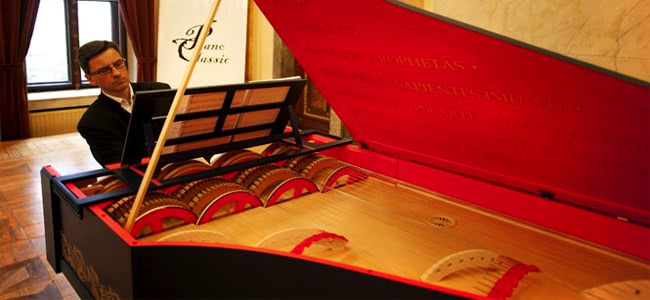Everyone’s heard of the Mona Lisa, but the famous painting’s Renaissance creator is known for a lot more than just his artwork.
Leonardo Da Vinci’s genius and ideas form the basis of many modern inventions that we take for granted, such as ball bearings, the diving suit, and even the precursor to the helicopter.
Well ahead of his time, the Italian Renaissance icon was also a talented musician, and among his many journals and manuscripts were ideas for some pretty bizarre and innovative musical instruments, many of which never made it beyond the realms of Da Vinci’s imagination and the sketches of his pages. Until now that is.
A Polish concert pianist – who’s a bit of a Renaissance man himself – has managed to bring to life one of Da Vinci’s hybrids, more 500 years after it was first conceived, as The Age reports.
The experimental musical instrument, dubbed the ‘viola organista’, is half-piano, half-cello and Da Vinci’s original idea – dating back as far as 1488 – was a combination of mechanical ingenuity and musical precision, a series of steel strings that are bowed by spinning wheels in what looks like a small scale grand piano.
After patiently drawing from and interpreting Da Vinci’s plans, spending three years and approximately 5,000 hours on his passion project, concert pianist Slawomir Zubrzycki has finished constructing his very own ‘viola organista’, and giving its first airing at the International Royal Krakow Piano Festival this time last month to an enraptured audience.
There are no historical records to suggest that Da Vinci managed to construct his ‘viola organista’ in his lifetime, nor anyone else for that matter, though a German musical tinkerer, Hans Haiden, did construct a similar instrument in 1575 called the Geigenwerk (‘The Fiddle Work’).
More recently, Japanese workshop maker Akio Obuchi, who builds modern keyboards based on historic models, attempted a number of constructions similar to Da Vinci’s model in the 90s before a modern tabletop version was used in a concert in Italy in 2004.
“This instrument has the characteristics of three we know: the harpsichord, the organ and the viola da gamba,’’ Zubrzycki explained of the instrument for its Academy Of Music debut at the Polish city of Krakow.
Inside the ornate midnight blue and gold trimmings beats a system that looks like a piano, but runs like more like the fanbelt motor engine of an automobile. Instead of dulcimers that hammer at the instrument’s sixty-one strings, there is a a series of rotating wheels that spin perpendicular to the strings, causing them to ‘bow’ the instrument mechanically.
These wheels are turned by a pedal below the keyboard, which Zubrzycki pumps as he plays – similar to an organ – which in turn cranks the wheels inside the body of the instrument. These spinning wheels, covered in horse-tail hair much like a vintage violin bow, play the strings in connection with the keyboard – which is laid out in the traditional ebony and ivory layout of your everyday piano.
(Image: AFP Photo. Source: Hindustan Times)
The result of the strings being ‘bowed’ instead of plucked or hammered gives the instrument its striking sonics, producing the rich deep tones of a cello but at the speed and precision of a piano player, especially a virtuoso like Zubrzycki.
“I have no idea what Leonardo Da Vinci might think of the instrument I’ve made,” says the pianist, “but I’d hope he’d be pleased.”
Zubrzycki’s unique creation is also presented in the most fanciful of ways, with a deep red adorning its complex innards, while gold leaf lettering embellishes the keyboard in a quote from Saint Hildegard, a 12th-century German nun, mystic, and philosopher that reads: ‘Holy prophets and scholars immersed in the sea of arts both human and divine, dreamt up a multitude of instruments to delight the soul.’
Zubrzycki’s viola organista has already ‘delighted the soul’ of fellow piano virtuosos for its Krakow debut.
Gabor Farkas, an Award-winning Hungarian concert pianist and Ferenc Liszt Academy of Music academic, gushed over the instrument and its “very warm sound, very velvety, very beautiful,” as AFP reports.
“I’ve fallen in love with this sound,” agrees Polish pianist Marian Sobula. “All pianists and string players yearn for it, for these long, never-ending notes which you can’t play on the piano. It just gives you goose bumps.”




































